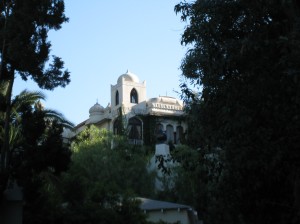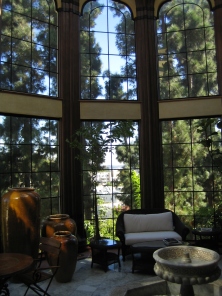Marie Russak Hotchener and Moorcrest: The Theosophist Opera Singer and Her Architectural Fantasia
July 6, 2009 § 7 Comments

Moorcrest/Photo by Hope Anderson Productions
Moorcrest stands on a hill overlooking Beachwood Drive. Its hybrid Moorish-Mission architecture, imposing size and prominent location lead many people, even Beachwooders, to assume it is a public building rather than a home. When I was working on my documentary, “Under the Hollywood Sign,” people kept asking if I had filmed the “temple” on Temple Hill Drive. They were surprised when I told them it was called Moorcrest and always had been a private home. (The Theosophical Society’s actual temple–the Temple of the Rosy Cross–is now part of the Krotona Apartments on Alta Vista Street, just to the south.)
Those who know Moorcrest is a home tend to call it “The Charlie Chaplin House.” While Chaplin did briefly live in Moorcrest, he was a renter and soon moved on, to a house he had his set builders construct for him (the infamously nicknamed “Breakaway House”) in Beverly Hills.

Retiring from the stage, Marie Russak began a new life as a rich Upper East Side matron but soon turned her sights to the wider world, moving to Paris with her husband in 1901. She had become a Theosophist in 1898 and deepened her commitment by relocating to the Theosophical Society’s headquarters in Adyar, Madras, India in 1906. (No word on what happened to her marriage, as Frank Russak seems to have stayed in Paris.) Her four years in India, where she studied under Annie Besant, not only schooled her in Theosophy but sowed the seeds of a new avocation: architecture.
In India, Marie Russak no doubt saw magnificent examples of the Mogul style that would inspire the Theosophist buildings of Beachwood. The arches, keyhole windows and domes of the Krotona Colony are directly inspired by India’s Islamic architecture of the 16th-18th centuries, the best-known example of which is the Taj Mahal. The Theosophical Society’s headquarters in Adyar, Madras (now Chennai), a hybrid of Indian and British Colonial styles, probably inspired the ecclecticism of the Beachwood’s Krotona Colony, whose buildings were as much Italianate and Spanish as Islamic in their derivation.



One of the small sitting areas, with red lotus windows

Porte Cochere

Living Room

Moorcrest's Atrium

Keyhole doorway
In his otherwise excellent study of Krotona architecture, “The Surviving Buildings of Krotona in Hollywood,” (Architronic vol. 8, 1998), Alfred Willis bemoans Marie Russak Hotchener’s lack of architectural training, dismissing her proportions as “awkward” and her interiors as “rather garish.” Further noting that all her houses were “somewhat vulgar,” he concedes that they reflect “their designer’s own middle-class taste but also the vulgarity increasingly evidenced in the commercial and domestic buildings of boomtime Los Angeles in the 1920’s.” That the hardly middle-class Marie Russak Hotchener was reaching for an architectural style as unique and hybridized as Theosophy itself apparently never occurred to him.
Tagged: "Breakaway House", Adyar, Alfred Willis, Alta Vista Street, Annie Bessant, Architronic, Beverly Hills, Charlie Chaplin, Chennai, Ecole des Beaux-Arts, Frank Russak, Helios Street, Henry Hotchener, India, Jesse Lasky, John Barrymore, Julia Morgan, Justin H. Smith, Krotona Apartments, Krotona Colony, Lucile Langhanke, Marie Barna, Marie Russak Hotchener, Mills College, Mogul architecture, Moorcrest, Newport, opera, Otto and Helen Langhanke, R.I., Religion, Taj Mahal, Temple Hill Drive, Temple of the Rosy Cross, Theosophical Society
§ 7 Responses to Marie Russak Hotchener and Moorcrest: The Theosophist Opera Singer and Her Architectural Fantasia
Leave a comment Cancel reply
This site uses Akismet to reduce spam. Learn how your comment data is processed.
Just to fill in a little history of Moorcrest. It did not become “abandoned” until the late 1990s. Prior to the 1994 earthquake, it was occupied for 30+ years by Pallie Bang – she and her husband raised their son there. They originally owned the entire property, but sold the portion with the old pool in the late ’70s, early 80s. (Urban legend says Chaplin filled the pool with sea water and trucked in white sand to put around it). The “abandoned” part your informant refers to was probably the pool area – the man who bought it planned to build something there but never did.
Pallie’s husband died and her son moved away. For a time, Pallie’s mother-in-law lived in the downstairs apartment. The day before the 1994 earthquake, Pallie moved her mother-in-law to a care facility. Fortuitous timing, since the quake lifted the house off it’s foundations. Pallie spent two years repairing Moorhouse, to the tune of several hundred thousand dollars. In the midst of the repairs, the orginal dome was destroyed – the builders were lifting it off with a crane and dropped it. Finally, when all the repairs were
completed, she sold it to a man who lived in Japan but had a fixation on Mary Astor (supposedly her old car was still sitting in the garage, but that may be another legend). This man would periodically have work done – including planting the ficus trees along Vesanta – but to the best of my knowledge, he never lived there. Then the Japanese economy crashed and he eventually sold the house (presumably to the people who tripled it’s size). I don’t know which of these owners bought back the pool property.
I lived around the corner from Pallie from 1989 to 1998, which is how I know these details!
Alis (former Beachwood Canyon resident)
Thanks for your comment. The woman I referred to knew the property when it was owned by the Japanese man, when no one was living there and the grounds went unwatered..
NOT HARRY! Aunt Marie was married to HENRY Hotchener, my mother’s brother. (Others in the family omitted the first “e” in Hotchener.) Neither in gatherings nor in surviving correspondence, is he called Harry. The photo of Marie, as diva, is a winner.
DEC 22,2011
Mr. Hotchener is called Harry as he is in the published sources I have referenced, not because of any bent toward nicknames on my part. Since you object, I have changed it to Henry.
My sister, Felice Holman Valen, is correct. His name was Henry and is so noted in census reports on the Hotchner family as early as 1910. I also knew him well during the 1940’s and ’50s — as Uncle Henry. You will find numerous mentions of him as Henry in Gene Fowler’s biography of John Barrymore,”Goodnight, Sweet Prince.” Henry Hotchner was, for a number of years, Barrymore’s agent.
Please see my reply to Felice Holman Valen.
[…] was designed by Marie Barnard Smith Russak Hotchener. It was built in 1921. Surprisingly, Hotchener didn’t have any background in architecture prior […]